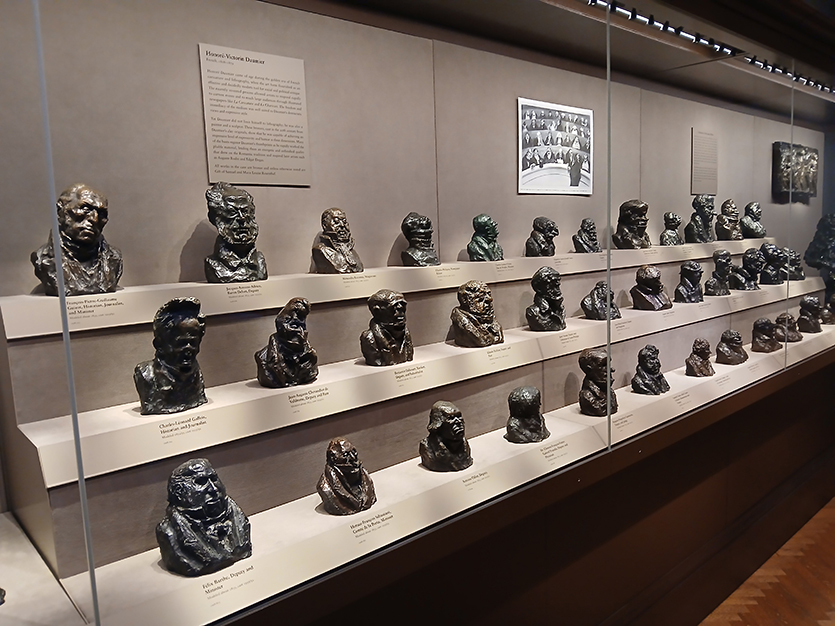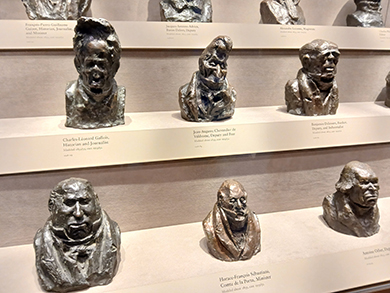Biographies in Bronze: Casting Honoré Daumier's Satirical Busts
Compositional studies provide insight into the foundries where the 19th-century political figures were cast in 20th-century Paris
In the 19th and early 20th centuries, Paris was home to scores of bronze foundries, making it the primary European center for the production of artistic bronzes, or bronzes d’art. These foundries were competitive, employing different casting methods—either lost-wax or sand casting—as well as closely guarded alloy and patina recipes. Recent studies have demonstrated that accurate measurements of the metal composition of these casts can provide art historians of 20th-century bronzes with a richer of understanding of an object’s biography, and help answer questions about provenance and authenticity. Center researchers used handheld XRF scanners to conduct compositional studies of 171 20th-century bronzes from known Parisian foundries. This data provides insight into diachronic aspects of Parisian foundry production, such as varying compositional ranges for sand casting and lost wax casting.
Indeed, the detailed knowledge of alloy composition is most illuminating when the interpretation of the data is embedded within a specific historical context. This way, the alloy data can be collated with biographical information about an artist, material evidence from dealers like catalogs and invoices, and foundry archives that may show invoices and casting processes. For this case study, Center researchers undertook research on a group of 20th century posthumous bronze casts of painted, unbaked clay caricature portrait busts by Honoré-Victorin Daumier (1808-1879) that are part of the collection at the Art Institute of Chicago.
 Daumier was a frequent contributor of satirical cartoons to the French satirical magazine La Caricature, and he initially intended the clay sculptures to serve as models for a series of lithographic portraits of contemporary figures associated with the political regime of Louis Philippe. These caricature portraits were printed in La Caricature from 1832-35, a height of considerable political instability—and satire—after the Paris Uprising of 1830. Daumier sold the clay figures to Charles Philipon, the editor of these publications.
Daumier was a frequent contributor of satirical cartoons to the French satirical magazine La Caricature, and he initially intended the clay sculptures to serve as models for a series of lithographic portraits of contemporary figures associated with the political regime of Louis Philippe. These caricature portraits were printed in La Caricature from 1832-35, a height of considerable political instability—and satire—after the Paris Uprising of 1830. Daumier sold the clay figures to Charles Philipon, the editor of these publications.
Ninety years later, Philipon’s family sold the clay caricature busts to Maurice Le Garrec, an art dealer and publisher who commissioned the sculptor Pierre-Felix Fix Masseau to repair the clay models and make molds of them. The plaster positives and retainers were then given to the Barbedienne foundry to make wax positive for the lost-wax casting process. Daumier’s busts were cast by multiple Parisian foundries: distinguishing among them is one goal of this project. There are collections of Daumier’s posthumously cast caricature busts in several other museums, including the National Gallery of Art, where prior studies have identified three date ranges for casting the figures: 1929-1930, 1929-1940, and 1929-1950.
The Art Institute’s collection is variable, with 18 attributed to the Barbedienne foundry and 2 attributed to the Valsuani foundry, based on the Valsuani mark. The Barbedienne sculptures do not have such identifying marks, although they do bear the mark of Maurice Le Garrec’s monogram. Sometimes there are edition marks to help with identification; the Dupin figure from the Worcester collection at the Art Institute has an edition number of 1. Other busts had later edition dates stamped, which provided some ways of understanding their chronology.
In 1935, all art bronzes produced in France that were composed of an alloy containing at least 65% copper had to be marked with the word “BRONZE” in order to distinguish them from brass. The “BRONZE” inscription provided some chronological framework for the majority of the busts in the Art Institute’s collection proposed to be cast by Barbedienne before the foundry closed, helping to establish that those with this stamp were cast between 1935 and 1952. If they did not have a foundry mark or a BRONZE inscription, researchers proposed that they were cast between 1929 and 1935.
 This project found several distinctions between Barbedienne’s and Valsuani’s casts of Daumier’s busts. The Valsuani alloys presented the highest concentrations of zinc and tin and the lowest concentrations of copper, with high levels of iron and chromium that were likely used in the salts used for the patina. The bronzes that were not stamped with the Valsuani mark and were suspected to be from the Barbedienne foundry had similar compositions to those identified as being Barbedienne-cast at the National Gallery of Art.
This project found several distinctions between Barbedienne’s and Valsuani’s casts of Daumier’s busts. The Valsuani alloys presented the highest concentrations of zinc and tin and the lowest concentrations of copper, with high levels of iron and chromium that were likely used in the salts used for the patina. The bronzes that were not stamped with the Valsuani mark and were suspected to be from the Barbedienne foundry had similar compositions to those identified as being Barbedienne-cast at the National Gallery of Art.
The differing zinc composition among the sculptures suggests distinctions in the casting process: sand casting techniques yield lower zinc levels, while higher zinc levels suggest lost-wax casting techniques. These distinctions point toward more material and economic historical research that might indicate why different foundries used the techniques: was it tradition, or practical casting limitations in temperature, fluidity, mold type. Some foundries like the Rudier foundry present a characteristic fingerprint and limited range of compositions—suggesting highly standardized foundry practices, tight control of raw material supplies, or both. The Valsuani foundry shows higher variability in the composition of its alloys—possibly linked to supply chain changes in raw materials, or perhaps a process of adaptation of its alloy to specific sculptures.
The project is part of a larger multi-institutional collaboration to scan works by Rodin, Pablo Picasso, Auguste Rodin, and several other artists, to build a database of bronze alloys that can be used for comparison of foundry archives and other records of the material histories of these sculptures.
Publication:
Pouyet, E., M. Ganio, A. Motlani, A. Saboo, F. Casadio, M. Walton. 2019. "Casting Light on 20th-Century Parisian Artistic Bronze: Insights from Compositional Studies of Sculptures Using Hand-Held X-Ray Fluorescence Spectroscopy." Heritage 2 (1): 732-748.
